Coyotes and Wolves
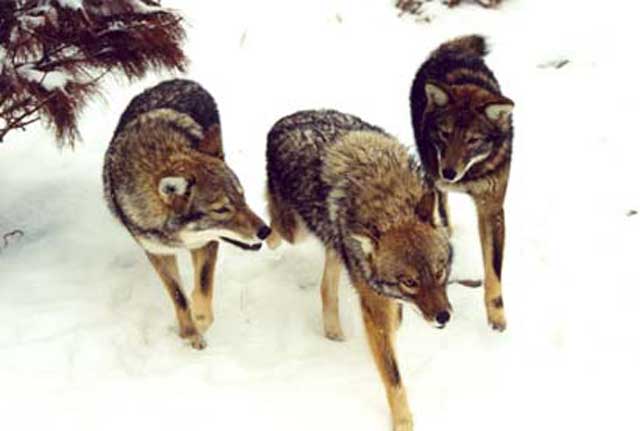 The
largest coyotes on record weighed 74¾ pounds (33.7 kg) and measured
over five feet in total length. During pursuit, a coyote may reach speeds up to
43 mph (69 km/h), and can jump a distance of over 4 meters (131/8 feet) (from
Wikipedia) Coyotes were once essentially diurnal, but have adapted to more nocturnal
behavior with pressure from humans (McClennen et al., 2001). Coyotes are capable
of digging their own burrows, though they often appropriate the burrows of groundhogs
or American badgers. Coyote territorial ranges can be as much as 19 kilometers
in diameter around the den, and travel occurs along fixed trails. In areas where
wolves have been exterminated, coyotes usually flourish. For example, as New England
became increasingly settled and the resident wolves were eliminated, the coyote
population increased, filling the empty biological niche. Coyotes appear better
able than wolves to live among people. Coyotes have been known to live a maximum
of 10 years in the wild and 18 years in captivity. They seem to be better than
dogs at observational learning. (from Wikipedia)
The
largest coyotes on record weighed 74¾ pounds (33.7 kg) and measured
over five feet in total length. During pursuit, a coyote may reach speeds up to
43 mph (69 km/h), and can jump a distance of over 4 meters (131/8 feet) (from
Wikipedia) Coyotes were once essentially diurnal, but have adapted to more nocturnal
behavior with pressure from humans (McClennen et al., 2001). Coyotes are capable
of digging their own burrows, though they often appropriate the burrows of groundhogs
or American badgers. Coyote territorial ranges can be as much as 19 kilometers
in diameter around the den, and travel occurs along fixed trails. In areas where
wolves have been exterminated, coyotes usually flourish. For example, as New England
became increasingly settled and the resident wolves were eliminated, the coyote
population increased, filling the empty biological niche. Coyotes appear better
able than wolves to live among people. Coyotes have been known to live a maximum
of 10 years in the wild and 18 years in captivity. They seem to be better than
dogs at observational learning. (from Wikipedia)
Hearing a coyote is much
more common than seeing one. The calls a coyote makes are high-pitched and variously
described as howls, yips, yelps and barks. These calls may be a long rising and
falling note (a howl) or a series of short notes (yips). These calls are most
often heard at dusk or night, but may be heard in the day.Coyotes are opportunistic,
versatile carnivores with a 90% mammalian diet, depending on the season. They
primarily eat small mammals, such as voles, prairie dogs, eastern cottontails,
ground squirrels, and mice, though they will eat birds, snakes, lizards, deer,
javelina, and livestock, as well as large insects and other large invertebrates.
Any species of birds that nests on the ground are targeted by coyotes. Though
they will consume large amounts of carrion, they tend to prefer fresh meat. Part
of the coyote's success as a species is its dietary adaptability. As such, coyotes
have been known to eat human rubbish and domestic pets. Fruits and vegetables
are a significant part of the coyote's diet in the autumn and winter months. Coyotes
shift their hunting techniques in accordance with their prey. When hunting small
animals such as mice, they slowly stalk through the grass, and use their acute
sense of smell to track down the prey. When the prey is located, the coyotes stiffen
and pounce on the prey in a cat-like manner. Coyotes will commonly work in teams
when hunting large ungulates such as deer. Coyotes may take turns in baiting and
pursuing the deer to exhaustion, or they may drive it towards a hidden member
of the pack.[5] When attacking large prey, coyotes attack from the rear and the
flanks of their prey. Occasionally they also grab the neck and head, pulling the
animal down to the ground. Coyotes are persistent hunters, with successful attacks
sometimes lasting as much as 21 hours; even unsuccessful ones can continue more
than 8 hours before the coyotes give up. Depth of snow can affect the likelihood
of a successful kill.[27] Packs of coyotes can bring down prey as large as adult
elk, which usually weigh over 250 kg (550 lbs).The average distance covered in
a night's hunting is 4 km (2½ mi).(from Wikipedia)
Wolves 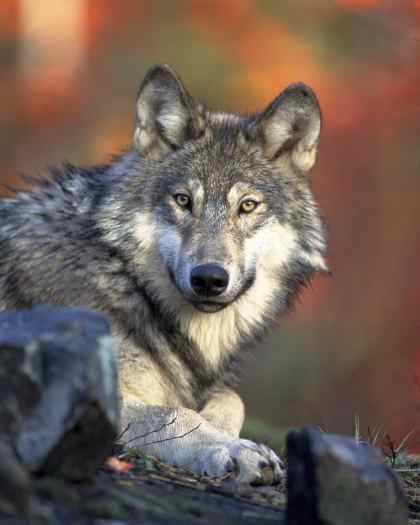
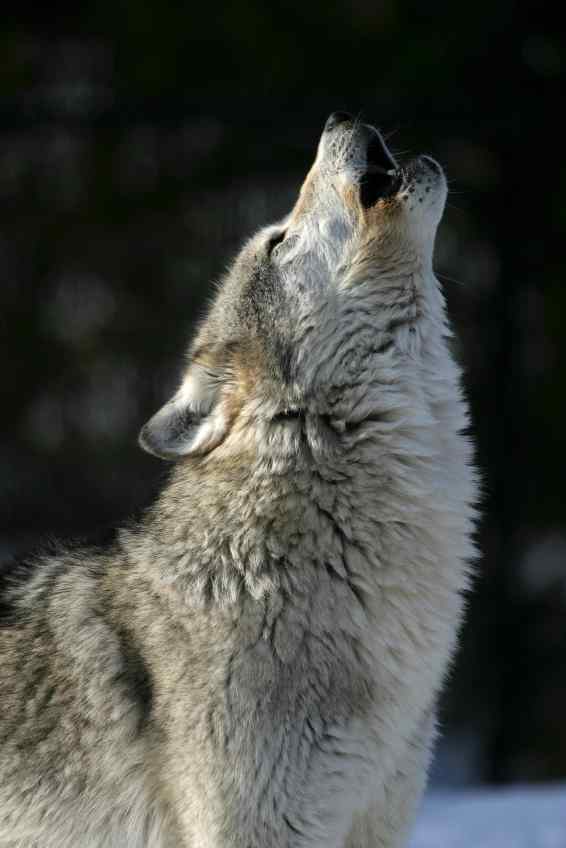
North American wolves
average 36 kg (80 lbs), but extreme specimens can be more than 77 kg (170 lb.)
The long canine teeth are also important, in that they hold and subdue the prey.
Capable of delivering up to 10,000 kPa (1450 lbf/in²) of pressure, a wolf's
teeth are its main weapons as well as its primary tools. This is roughly twice
the pressure that a domestic dog of similar size can deliver. Packs can contain
between 2 and 20 wolves, though 8 is a more typical size. An unusually large pack
consisting of 36 wolves was reported in 1967. Female wolves tend to be better
at chasing prey than males, while the latter are more adept at wrestling large
prey to the ground once it is caught. Packs composed largely of female wolves
thrive on fleet footed prey such as elk, while packs specialising in bison tend
to have a greater number of males. Though commonly portrayed as targeting solely
sick or infirm animals, there is little evidence that they actively limit themselves
to such targets. Rather, the evidence shows that wolves will simply target the
easiest options available, which as well as sick and infirm animals, can also
include young animals and pregnant females. Though wolves commonly hunt large
prey in packs, there are cases in which single wolves have successfully killed
large animals unaided. One wolf was recorded to have killed moose 11 times singlehandedly.
(from Wikipedia)
Pioneer settlers had to take precautions against the above.
Many settlers were killed by them and a great deal of livestock was lost to them.
Wolves and Coyotes usually had bountys on them and were shot on sight. The Macomb
County area was not safe for many years.
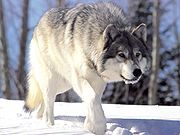
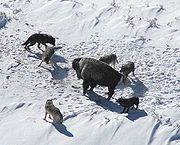 At left wolves ready to
take down a bison
At left wolves ready to
take down a bison
 The
largest coyotes on record weighed 74¾ pounds (33.7 kg) and measured
over five feet in total length. During pursuit, a coyote may reach speeds up to
43 mph (69 km/h), and can jump a distance of over 4 meters (131/8 feet) (from
Wikipedia) Coyotes were once essentially diurnal, but have adapted to more nocturnal
behavior with pressure from humans (McClennen et al., 2001). Coyotes are capable
of digging their own burrows, though they often appropriate the burrows of groundhogs
or American badgers. Coyote territorial ranges can be as much as 19 kilometers
in diameter around the den, and travel occurs along fixed trails. In areas where
wolves have been exterminated, coyotes usually flourish. For example, as New England
became increasingly settled and the resident wolves were eliminated, the coyote
population increased, filling the empty biological niche. Coyotes appear better
able than wolves to live among people. Coyotes have been known to live a maximum
of 10 years in the wild and 18 years in captivity. They seem to be better than
dogs at observational learning. (from Wikipedia)
The
largest coyotes on record weighed 74¾ pounds (33.7 kg) and measured
over five feet in total length. During pursuit, a coyote may reach speeds up to
43 mph (69 km/h), and can jump a distance of over 4 meters (131/8 feet) (from
Wikipedia) Coyotes were once essentially diurnal, but have adapted to more nocturnal
behavior with pressure from humans (McClennen et al., 2001). Coyotes are capable
of digging their own burrows, though they often appropriate the burrows of groundhogs
or American badgers. Coyote territorial ranges can be as much as 19 kilometers
in diameter around the den, and travel occurs along fixed trails. In areas where
wolves have been exterminated, coyotes usually flourish. For example, as New England
became increasingly settled and the resident wolves were eliminated, the coyote
population increased, filling the empty biological niche. Coyotes appear better
able than wolves to live among people. Coyotes have been known to live a maximum
of 10 years in the wild and 18 years in captivity. They seem to be better than
dogs at observational learning. (from Wikipedia) 


 At left wolves ready to
take down a bison
At left wolves ready to
take down a bison